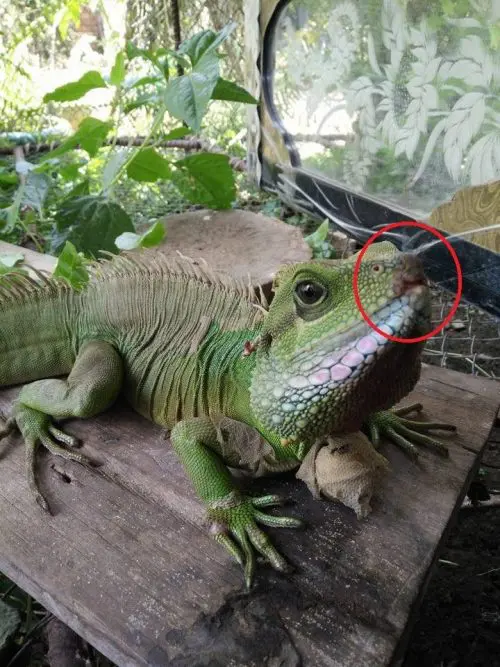As a Chinese water dragon owner, you want to know the telltale signs that your dragon may be sick, enabling you to act quickly and secure the treatment that they need.
Being a pet owner comes with a lot of responsibility and meeting your reptile’s health needs helps you ensure that they remain happy, healthy, and fit in the long run.
Common Chinese Water Dragon Sick Symptoms
- Lethargy
- Sleeping too much
- Blisters on skin
- Vomiting
- Weight loss
- Blood in feces
- Runny feces for more than two days
- Sunken eyes
- Lack of appetite
- Gasping, forced exhalation, wheezing, and clicking noises
- Bubbling mucus around nose, mouth, and eyes
- Bloating
- Inability to poop
- Mouth open
- Inability to walk
- Dragging limbs
- Redness with cheese like pus from mouth
Metabolic Bone Disease
Metabolic bone disease is common in Chinese water dragons who do not have enough Vitamin D3 in their diet to metabolize calcium.
Use a UVB light in the enclosure and gut load your live food with calcium to ensure that you reduce the risk of this bone disease in the long run.
Parasites
Parasites and bacteria can result in numerous health issues for Chinese water dragons. This can result in weight loss, stunted growth, damage to the intestinal lining, and death.
The most common parasites in these dragons include nematodes, protozoans, tapeworms, salmonella, and more.
Signs of parasites include weight loss, runny feces, blood in feces, lethargy, bloating, and loss of appetite.
Freshwater and a clean cage can reduce the risk of parasites in your dragon.
Vitamin Deficiency
A varied diet is the best for a Chinese water dragon, but ensure that you are providing a healthy and well-balanced diet where your pet can get all the vitamins and minerals it needs to stay fit and healthy.
Gut load live foods and supplement regularly for best results.
Mouth Rot

Mouth rot is an infection of the gums and mouth and is often identified by red and swollen gums, pus around the mouth, and discomfort.
Chinese water dragons are known for rubbing and banging their head against the glass of the enclosure, causing injuries which then become infections.
Seek veterinary assistance to get essential antibiotics to help improve your dragon’s health quickly.
Related – More information about how to treat and prevent mouth rot in Chinese water dragons.
Respiratory Infection
Chinese water dragons can get a respiratory infection from something as simple as a low tank temperature, which weakens their immune system.
Constant high humidity and poor living conditions can also result in respiratory infection.
Signs include bubbling mucus around eyes nose and mouth, loss of appetite, a puffy appearance with lethargy, wheezing, clicking noises, and open mouth.
Related – Detailed information about Chinese water dragon respiratory infection.
Egg Binding / Dystocia
Egg binding is when your female dragon is unable to lay some or all of her eggs. There are numerous reasons for this, including weakened bones and muscles, a lack of heat or UV rays, calcium deficiency, and more.
Provide a box to lay eggs, bearing in mind that in the wild they take their time in finding a spot to lay the eggs due to the vulnerability of the situation.
If you have any thoughts that your dragon may be suffering from egg binding, then visit the vet soonest to carry out an examination and remove the eggs as this can be a life threatening condition.
Injuries
Chinese water dragons are inquisitive and will explore with confidence, both inside and outside the enclosure. This can result in falls from high areas in the home, breaking tails, bones, and more. Tail tips, lost toes, and digits don’t grow back.
In the event of any breaks, take your dragon to the vet to disinfect and treat the wound properly.
Dragon Turning Brown
A dragon that turns brown or dark brown is trying to tell you something, don’t ignore it. Most dragons will change color to brown if they are sick, cold, or stressed.
It’s not uncommon for dragons to change colors throughout the day as they warm up, but if you find that your dragon is staying brown for extended periods, then it may be sick and require veterinary treatment.
Skin Infections
If the enclosure is very humid, then your dragon may develop a skin infection. This can be due to poor ventilation, unsanitary living conditions, and a weakened immunity.
Blisters can form on the skin of the dragon; they look like bumps or blisters filled with a yellow liquid. This is sometimes accompanied by brown patches.
Mites
Mites can occur in dragon enclosures and are visible to the naked eye as small blackish dots on the dragon’s skin. Mites suck the blood of the dragon, causing discomfort and stress.
The tank will need to be disinfected, including the substrate.